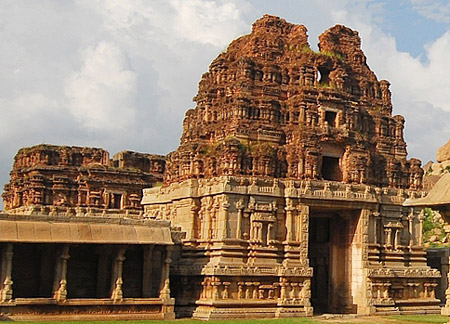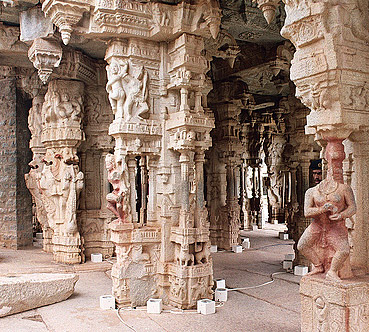The architecture of the temples in Vijayanagara is stylistically very similar. However the difference lies in the variety and quality of Vijayanagara temple sculptures. The halls and the temples in Vijayanagara had been artistically created keeping in mind the tradition of different dynasties that reigned in Vijayanagara.
 The temple sculptures of this ancient kingdom are elaborate and ethnic. The Tiruvengalanatha temple, for instance, appear to be elaborate and it stands exemplary of the Vijayanagara temple sculpture. With the popularity of the Tamil tradition, the temples in Vijayanagara received a new touch in the field of sculpture. The artisans also followed the Deccan style of architecture followed by decorative themes and narrative sculpture. Sometimes the temples used to incorporate a variety of non-iconographic and secular themes. Besides numerous depictions of deities and semi-divine beings, a plethora of other motifs abound in the sculptural repertoire of the city: royal or noble personages engaged in varied pursuits, acrobats and wrestlers, clowns and foreigners, dancers and musicians, soldiers, ascetics of different types, hunters and huntresses, servitors and devotees, diverse animals and birds, floral, vegetal and geometric designs and so on.
The temple sculptures of this ancient kingdom are elaborate and ethnic. The Tiruvengalanatha temple, for instance, appear to be elaborate and it stands exemplary of the Vijayanagara temple sculpture. With the popularity of the Tamil tradition, the temples in Vijayanagara received a new touch in the field of sculpture. The artisans also followed the Deccan style of architecture followed by decorative themes and narrative sculpture. Sometimes the temples used to incorporate a variety of non-iconographic and secular themes. Besides numerous depictions of deities and semi-divine beings, a plethora of other motifs abound in the sculptural repertoire of the city: royal or noble personages engaged in varied pursuits, acrobats and wrestlers, clowns and foreigners, dancers and musicians, soldiers, ascetics of different types, hunters and huntresses, servitors and devotees, diverse animals and birds, floral, vegetal and geometric designs and so on.
The depictions of Vasantotsava occur early in the sculptural repertoire at Vijayanagara. It was an interesting theme, but not one of the major ones in Vijayanagara art, for there are only a limited number of illustrations of Vasantotsava at the site. Also, there are no large sculptures on this theme or any of outstanding artistic quality. Yet Vasantotsava reliefs in Vijayanagara sculpture are of importance for they throw light on facets of the religious, social and courtly life of the city. Besides this, in due course of time, this theme which was first popularized at Vijayanagara was to pass into the sculptural repertoire of the Vijayanagara and Nayaka period in monuments throughout southern India and to emerge as a very significant motif. This later flowering of the Vasantotsava theme in Vijayanagara-Nayaka art had its genesis in these illustrations at Hampi from the late fourteenth or early fifteenth century onwards. The majority of the sculptures, such as the ones from the Ramachandra temple, the Mahanavami Platform, the Royal Enclosure and the Huchchappa-matha apparently portray court-connected festivities during Vasantotsava. The celebration of this festival involved not only the play with water in which even the king took part along with women of his court and household, but also other forms of entertainment such as music and dance, acrobatic activities and the foolery of jesters. Romance and amorous dalliance also obviously formed part of this celebration commemorating Kama"s return.
On the plinth mouldings of the "mahamandapa" of the Vitthala temple too, on the east and south sides, are friezes of women dancing and of women and men engaged enthusiastically in water-play. There is also a pillar-relief illustrating this theme in the "rangamandapa" of this temple. In the south-east corner pavilion of the Vitthala complex on the south side is the ceiling carving of Kama with his attendants participating in a mock-battle. On the other hand, in the decorative circular ceiling panel on the west side is a circle of women and men engaged in spirited water-play. Two large tubs are nearby; in one three women are standing, of whom two hold syringes; in the second there is one woman. Two step-wells are also carved, each with a woman immersed in it. The circular ceiling deco¬ration on the east side has a circle of pairs of men and women dancing, while on the ceiling of the north side is a ring of stick-dancers. This "mandapa" has the maximum number of representations at Vijayanagara of the god of love and of humans celebrating the Holi. Since this "mandapa" is believed to be a "kalyana-mandapa" (marriage-hall), the carvings done on it are of greater importance.
The portrayal of water-play also appears among the reliefs on the plinth of the "gopura" of the Ramanuja temple, located north-east of the Vitthala temple. In the hundred-pillar hall of the Pattabhirama temple there are long friezes on this theme on the recessed slabs below the raised ceiling of the central open space. The most elaborate sculptural rendering of the exuberant activities associated with Vasantotsava is discovered in the medium-sized Vishnu temple, with a "gopura", in the eastern end of the "royal centre", near the Jaina group of temples.
The temple sculptures in Vijayanagara incorporate martial themes because of the fact that the rulers of Vijayanagara were constantly engaged in combat. Given the military nature of the Vijayanagara statehood and also given the presence of numerous secular themes in Vijayanagara sculpture, one would expect to see martial themes frequently represented in Vijayanagara art. Martial themes in sculpture at the site can be broadly classified into three categories that are depictions of military parades, scenes of armies in action and the motif of warriors riding on mythical beasts that appear on some of the composite-pillars of the sixteenth century. Of these three types of martial themes in Vijayanagara sculpture at the capital, the military parades are the most significant. But this variety, found only in the early phase, does not pass into the sculptural repertoire of the late Vijayanagara and during the ruling period of Nayaka dynasty. Sculptural renderings of armies in action, too, do not survive as a significant theme in later monuments. They are mainly found in the few reliefs carved on the bases of some of the columns bearing the magnificent sculptures of mounted warriors in combat. Though in Vijayanagara city the theme of the soldier on the rearing animal is not a major motif, this was the martial theme that was eventually to emerge as the most important.
Sometimes in the sculptures of Vijayanagara myriads of themes, both religious and secular, appear. New iconographic forms were introduced and variations, not strictly according to canonical rules, occur in certain pre-existing ones. Of interest is the frequency or the rarity of the occurrence of certain motifs or icons, as well as the places they are found in and also the period of their occurrence. Among the thousands of sculptures found at the site, scattered on rocks and boulders, stone slabs, walls and different parts of religious and even secular edifices, is one very small and rather insignificant depiction of Lord Krishna as Vatapatrasayi (the form of the baby Krishna lying on a banyan leaf, afloat on the cosmic ocean).
The Vijayanagara variations in the Krishna sculptures are Madanagopala, or the eight-armed Krishna playing on the flute, the multi-legged Venugopala within a circle and Krishna encased within the type of "prabhavali" generally associated with the Nataraja image. The first of these is the most important and it entered the southern Indian sculptural repertoire from Vijayanagara times onwards. Different types of Krishna sculptures that are extant at Vijayanagara include carvings on lintel slabs, reliefs on temple pillars and plinths, reliefs on the memorials of Madhva saints, reliefs on the walls of temples, enclosure and gateways, statues in the round, carvings on stone slabs and, lastly, stucco figures.
 The plinth of Vitthala temple comprises intricately cut mouldings, including the one on which is carved a frieze of Portuguese leading horses. Set along the three open sides of the plinth are ten elaborately sculpted niches, each containing an image of one of the ten avataras of Lord Vishnu. From aesthetic point of view the sculptures are significant and its importance lies in its uniqueness and in the fact that it is an innovation in Vijayanagara sculpture and iconography. It is probable that in the conscious promotion of Vaishnavism by the iconic themes hitherto not prevalent, besides a variety of religious festivals and rituals, were deliberately fostered. The Vatapatrasayi icon may have been one such theme. Timmaraja and his siblings made their benefactions at Vijayanagara in and around the Vitthala complex. Evidently they felt a great devotion to Vitthala and to Krishna of whom the former is a manifestation. This may be another reason for the introduction of this new icon of Krishna.
The plinth of Vitthala temple comprises intricately cut mouldings, including the one on which is carved a frieze of Portuguese leading horses. Set along the three open sides of the plinth are ten elaborately sculpted niches, each containing an image of one of the ten avataras of Lord Vishnu. From aesthetic point of view the sculptures are significant and its importance lies in its uniqueness and in the fact that it is an innovation in Vijayanagara sculpture and iconography. It is probable that in the conscious promotion of Vaishnavism by the iconic themes hitherto not prevalent, besides a variety of religious festivals and rituals, were deliberately fostered. The Vatapatrasayi icon may have been one such theme. Timmaraja and his siblings made their benefactions at Vijayanagara in and around the Vitthala complex. Evidently they felt a great devotion to Vitthala and to Krishna of whom the former is a manifestation. This may be another reason for the introduction of this new icon of Krishna.
Thus, the uniqueness of the temple sculptures of Vijayanagara with decorative motifs heralds a new step in iconographic development within the repertoire of representations of different sides of and aspects of the city.



















